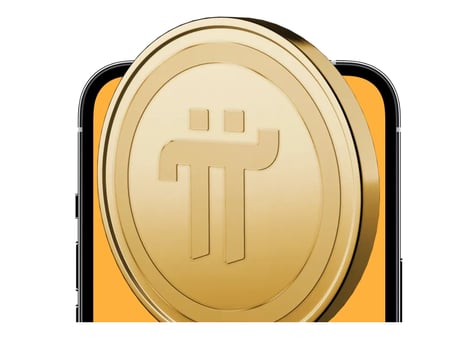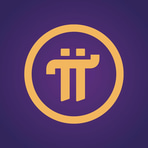Pi Network Coin (PI) – Overview, Price & How to Buy
Learn where and how to buy Pi Network Coin easily and securely.
Discover the Pi Network Coin
Pi Network Coin (PI) is a new cryptocurrency that has rapidly grown a massive community by enabling users to mine coins on their mobile phones with minimal effort. Launched in 2019 by a team of Stanford PhDs, Pi Network aims to build “the world’s most inclusive peer-to-peer ecosystem” fueled by its Pi Coin. After several years of development in a closed environment, Pi’s blockchain Open Mainnet finally went live in February 2025 – allowing Pi Coin to be traded on exchanges and used outside the Pi app for the first time. This page provides an in-depth overview of the Pi Network project, its key features, the current Pi Network Coin price, and guidance on how to buy Pi Coin on major platforms like OKX, Binance, and Gate.io.


Overview of the Pi Network Project
Pi Network is a mobile-first cryptocurrency project focused on accessibility and widespread adoption. Officially launched on March 14, 2019 (Pi Day) by a team of Stanford University graduates, the project set out to overcome key barriers to crypto adoption. The core idea is simple yet ambitious: allow anyone to participate in crypto mining using just their smartphone. Unlike Bitcoin’s energy-intensive Proof-of-Work mining, which requires powerful hardware, Pi’s innovative consensus mechanism lets users “mine” Pi by checking into a mobile app daily. This process doesn’t consume significant battery or data – it’s more of a gamified contribution system than literal hash crunching.
From its inception, Pi Network put heavy emphasis on building a large, engaged community. The project refers to its users as “Pioneers,” and over the years it attracted tens of millions of them. In fact, Pi’s community has grown to over 60 million members worldwide, all earning Pi through the mobile app. This massive user base was achieved by making crypto mining free and accessible – anyone with a phone can tap a button daily to receive Pi, putting “power into the hands of people worldwide for a fairer, more distributed crypto.” The Pi Network founders believed that true decentralization and utility come from broad participation, so they designed the network to empower real individuals rather than wealthy miners or bots.
During its early years, Pi operated in an enclosed network mode. Users could earn Pi and even use it within Pi’s in-app marketplace, but the coin had no external value – it couldn’t be traded for fiat or other crypto, and transfers were restricted to inside the network. This was intentional: the Pi Core Team wanted to grow the community and build the blockchain’s infrastructure (including KYC identity verification) before opening the gates to the outside world. By requiring KYC (Know Your Customer) verification for its millions of users, Pi aimed to ensure that each account represents a real human and to prevent abuses. Security and trust were paramount, as the network’s consensus relies on social trust circles rather than energy expended.
After years of anticipation, Pi Network reached a critical milestone in February 2025. The project transitioned from its Enclosed Mainnet to an Open Mainnet, meaning the firewall preventing external connections was lifted. Pi announced that at 8:00 AM UTC on Feb 20, 2025, external transactions would be enabled. This open-network launch finally allows Pi Coins to be withdrawn to external wallets, traded on exchanges, and integrated with other platforms. In the lead-up to this event, Pi Network surpassed key internal goals: over 10 million users had completed Mainnet migration of their balances, and 19 million+ users passed KYC identity verification, helping ensure the network’s integrity. With the doors now open, Pi Network is aiming to evolve into a full-fledged Web3 platform, complete with a growing ecosystem of community-built apps and use cases for Pi.
Key Features and Benefits of Pi Coin
Mobile Mining Accessibility: Pi is designed to be mined on smartphones via a free app, with minimal battery or CPU drain. This approach lets everyday people participate in crypto without specialized equipment or cost.
Inclusive & Massive Community: With over 60+ million engaged members globally, Pi Network boasts one of the largest communities in crypto.
Free Distribution (No Pay-to-Play): Unlike many crypto projects, Pi did not raise funds via an ICO or require users to purchase tokens up front. Pi Coins are earned by contributing to the network, not bought from the project.
Energy-Light & Eco-Friendly: Pi’s consensus mechanism is extremely low-energy compared to Bitcoin or Ethereum’s early Proof-of-Work era.
Security through KYC Verification: To prevent fake accounts and maintain network integrity, Pi Network implemented a large-scale KYC verification program.
Utilities and Apps Ecosystem: Pi Network is not just a coin; it’s envisioned as a full platform for decentralized applications (dApps) and services.
Active Core Team & Ongoing Development: Pi’s core team of 35+ members globally (with headquarters in Silicon Valley) continues to update the project.
Pi Network Coin Price and Market Status
Pi Coin’s price is a hot topic now that the token is tradeable on the open market. As of mid-2025, the live Pi Network coin price is around $0.70 USD, giving it a market capitalization of roughly $5 billion based on circulating supply. This places Pi Coin among the top 30 cryptocurrencies by market cap. Notably, only about 7.3 billion PI (around 7% of the max supply) is currently circulating. Pi’s max supply is 100 billion tokens.
When Pi first enabled external trading in February 2025, the price saw a rollercoaster of volatility. On debut day, Pi Coin opened around $1.70 and quickly spiked to $2.00, before plunging by about 50% within hours. Early excitement drove the price up, but with limited liquidity and many holders unable (or unwilling) to sell initially, the market corrected sharply.
Since that volatile launch, Pi’s price has stabilized in the range of a few tenths of a dollar. Over the months following mainnet launch, PI hovered between roughly $0.10 and $3.00, and lately trades around the $0.6–$0.8 range. The current price of ~$0.70 represents a significant climb from its initial low.
In terms of market status, Pi Coin is now officially listed on several exchanges. There is optimism among supporters that as more of those tens of millions of users gain access to their Pi and new investors learn about the project, demand could increase. The project’s long enclosed period and unusual launch have led to some caution from crypto analysts. Going forward, Pi’s price will likely be influenced by exchange listings, overall crypto market trends, and progress in building its ecosystem.
How and Where to Buy Pi Coin (OKX, Binance, Gate.io)
To purchase Pi, first register an account on a cryptocurrency exchange that lists the PI token. Two of the leading platforms trading Pi Coin are OKX and Gate.io. Sign up with your email or phone number, and complete any required identity verification (KYC) to enable trading features. Binance users cannot directly buy Pi on Binance yet, but you can use Binance to buy USDT and then transfer it to an exchange like OKX to trade for Pi.
Once your account is set up, deposit funds that you will use to exchange for Pi. You could buy USDT on an exchange like Binance or Coinbase, then send that USDT to your OKX or Gate.io wallet address.
On your chosen exchange, navigate to the spot trading section and search for “PI”. Pi Coin is typically paired with Tether (USDT), so look for the PI/USDT trading pair. You can place a market order or a limit order. After buying Pi, you can leave the coins on the exchange or withdraw to a secure wallet.
Currently, OKX and Gate.io are the go-to exchanges for Pi. Binance has not confirmed any listing as of the latest update. Until then, use OKX and Gate.io for legitimate Pi trading.
Pi Coin vs Other Cryptocurrencies
Bitcoin: Pi Coin has a much larger supply and uses a different mining mechanism. Pi is mined on smartphones; Bitcoin requires powerful hardware. Bitcoin is a store of value, Pi aims for everyday usage.
Ethereum: Both support dApps, but Ethereum is much more mature. Pi has a broader user base via mobile phones. Ethereum’s ecosystem is vast; Pi is just beginning.
Other Altcoins: Pi is often compared to Stellar (similar consensus), Electroneum (mobile mining), or Dogecoin (community-driven). Pi’s distribution is more democratic, with no ICO or major whales.
Frequently Asked Questions about Pi Coin
What is Pi Network and Pi Coin? Pi Network is a mobile-based blockchain that allows users to mine Pi Coin by checking into the app daily. It launched in 2019 and transitioned to an open mainnet in 2025.
How does Pi’s mobile mining work? Users tap a button in the app every 24 hours to earn Pi. It uses a trust algorithm rather than computational power.
Where can I buy Pi Coin? You can buy Pi Coin on exchanges like OKX and Gate.io. It is not yet listed on Binance or Coinbase.
Is Pi Coin listed on Binance or Coinbase? Not yet. Binance has held a community poll about listing Pi. For now, use OKX or Gate.io.
What is the current price of Pi Coin? As of mid-2025, the price is around $0.70, but this can fluctuate.
What is the total supply of Pi Coin? The maximum supply is 100 billion PI. About 7.3 billion are in circulation.
Is Pi Network a scam or legit project? Pi appears to be a legitimate project with real founders and millions of users. It has transitioned to mainnet and is now traded openly.
How can I use Pi Coin? Currently, Pi can be traded or held in a wallet. The ecosystem of apps accepting Pi is growing.
